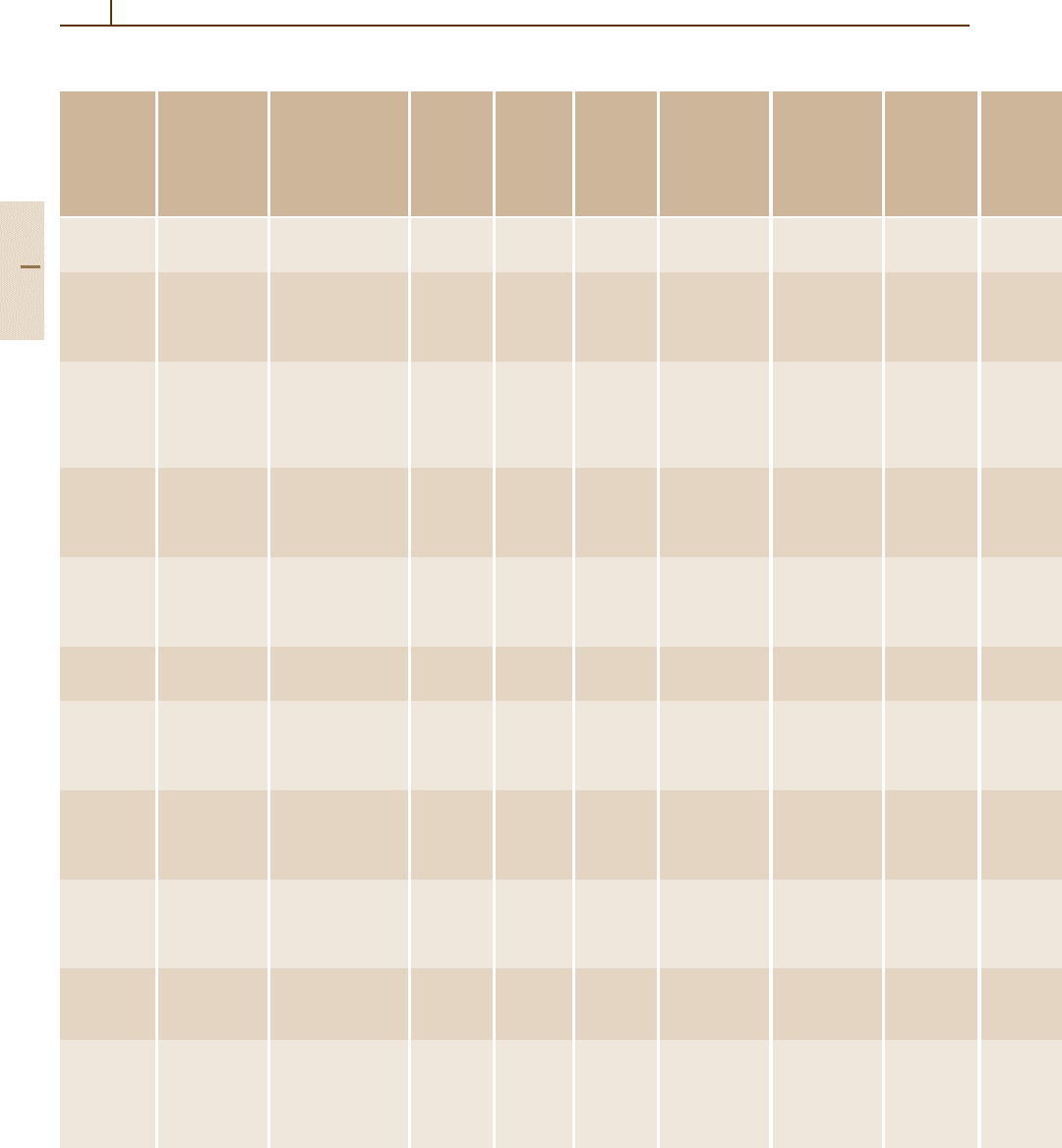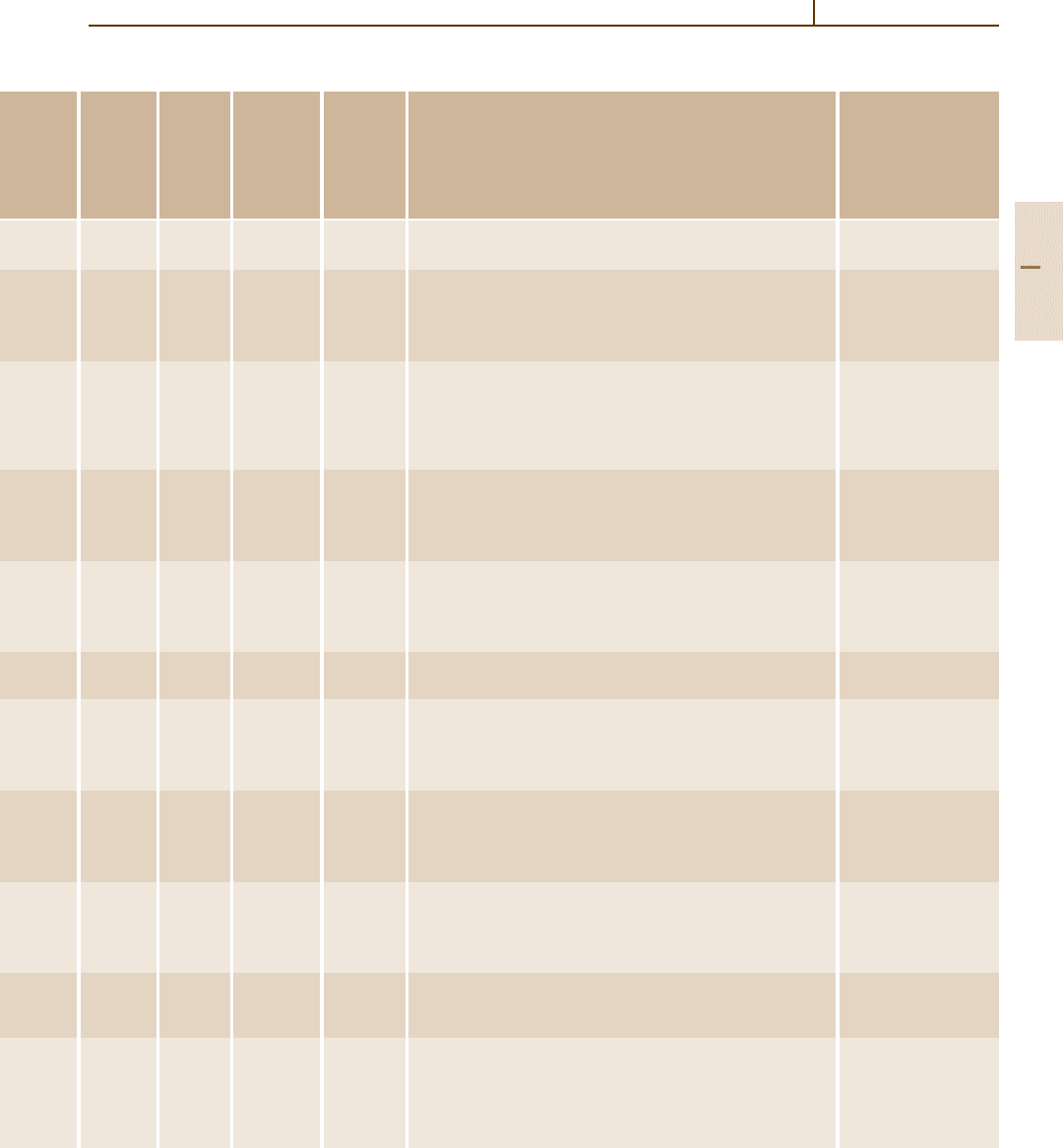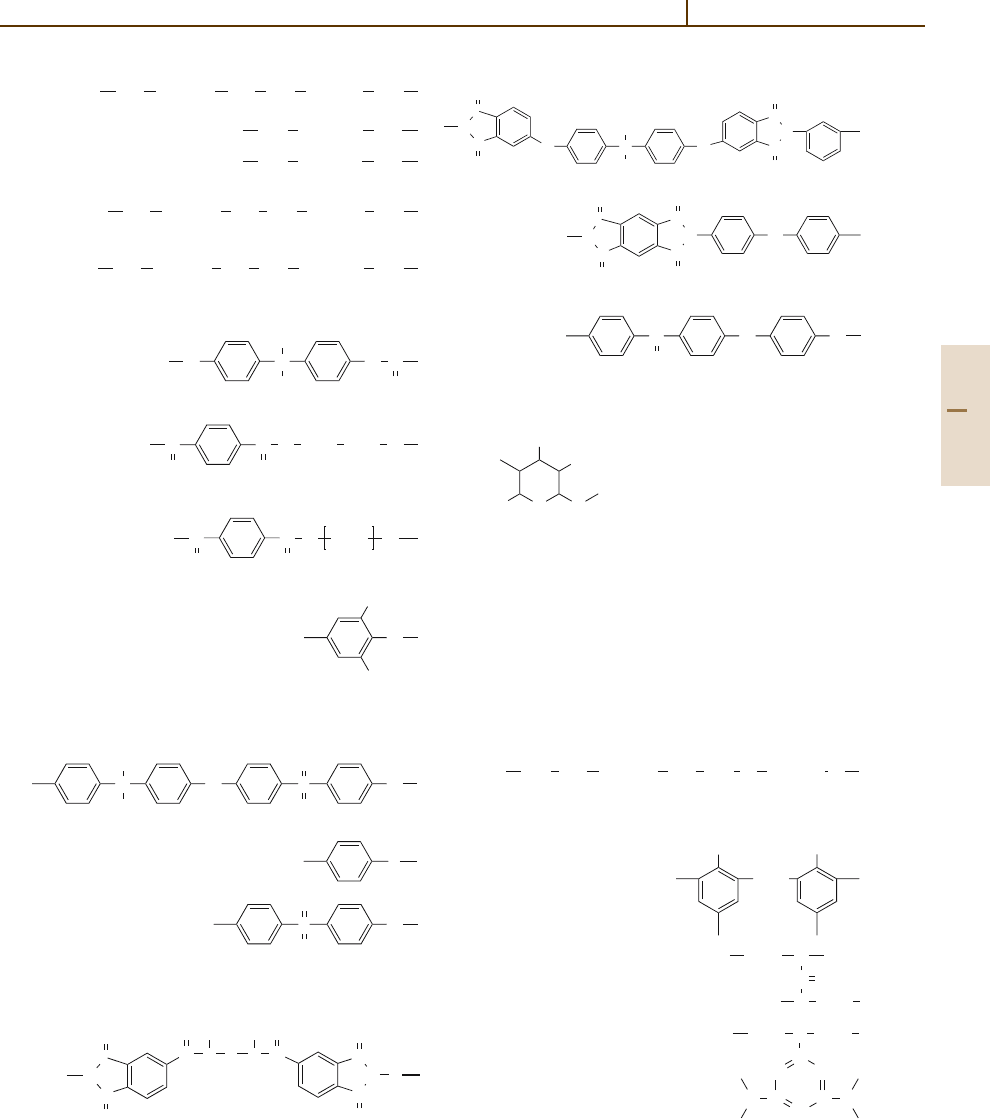Martienssen W., Warlimont H. (Eds.). Handbook of Condensed Matter and Materials Data
Подождите немного. Документ загружается.


472 Part 3 Classes of Materials
Table 3.2-24 Characteristics of Si
3
N
4
powders processed by different preparation techniques [2.3]
Technique
Nitridation Chemical vapor Carbothermal Diimide
of Si deposition reduction precipitation
Sample no. 1212 12
Specific surface area (m
2
/g) 23 11 410 10 11 13
O(wt%) 1.4 1.0 1.0 3.0 2.0 1.4 1.5
C(wt%) 0.2 0.25 −− 0.9 0.1 0.1
Fe, Al, Ca (wt%) 0.07 0.4 0.005 0.005 0.22 0.01 0.015
Other impurities (wt%)
Cl 0.04
Mo +Ti 0.02
Cl 0.1 Cl 0.005
Crystallinity (%) 100 100 60 0 100 98 −
α/(α +β) (%) 95 92 95 − 98 86 95
Morphology
a
EEE +RE+R E +R EE
a
E, equiaxed; R, rod-like.
Table 3.2-25 Physical properties of silicides and silicide-based high-temperature refractories [2.4]
IUPAC name Theoretical
chemical
formula,
[CASRN],
relative
molecular mass
(
12
C =12.000)
Crystal system,
lattice parameters,
Strukturbericht
symbol,
Pearson symbol,
space group,
structure type, Z
Density
(,kg m
−3
)
Electrical
resistivity
(ρ,µ cm)
Melting
point (
◦
C)
Thermal
conductivity
(κ, Wm
−1
K
−1
)
Specific heat
capacity
(c
p
,Jkg
−1
K
−1
)
Coefficient
of linear
thermal
expansion
(α,10
−6
K
−1
)
Chromium
disilicide
CrSi
2
[12018-09-6]
108.167
Hexagonal
a =442 pm
c =635 pm
C40, hP9, P6
2
22,
CrSi
2
type (Z = 3)
4910 1400 1490 106 – 13.0
Chromium
silicide
Cr
3
Si
[12018-36-9]
184.074
Cubic
a =456 pm
A15, cP8, Pm3n,
Cr
3
Si type (Z = 2)
6430 45.5 1770 – – 10.5
Hafnium
disilicide
HfSi
2
[12401-56-8]
234.66
Orthorhombic
a =369 pm
b =1446 pm
c =346 pm
C49, oC12, Cmcm,
ZrSi
2
type (Z = 4)
8030 – 1699 – – –
Molybdenum
disilicide
MoSi
2
[12136-78-6]
152.11
Tetragonal
a =319 pm
c =783 pm
C11b, tI6, I 4/mmm,
MoSi
2
type (Z = 2)
6260 21.5 1870 58.9 – 8.12
Niobium
disilicide
NbSi
2
[12034-80-9]
149.77
Hexagonal
a =479 pm
c =658 pm
C40, hP9, P6
2
22,
CrSi
2
type (Z = 3)
5290 50.4 2160 – – –
Tantalum
disilicide
TaSi
2
[12039-79-1]
237.119
Hexagonal
a =477 pm
c =655 pm
C40, hP9, P6
2
22,
CrSi
2
type (Z = 3)
9140 8.5 2299 – – 8.8 – 9.54
Part 3 2.5

Ceramics 2.5 Non-Oxide Ceramics 473
3.2.5.5 Silicides
Silicides, being compounds of silicon with metals,
mostly show a metallic luster. Like intermetallic phases
the silicides of a metal may occur in different stoichio-
metric variants, e.g. Ca
2
Si, Ca
5
Si
3
, and CaSi. Silicides
of the non-noble metals are unstable in contact with
Table 3.2-25 Physical properties of silicides and silicide-based high-temperature refractories [2.4], cont.
Young’s
modulus
(E,GPa)
Flexural
strength
(τ,MPa)
Compressive
strength
(α,MPa)
Vickers
hardness
HV
(Mohs
hardness
HM)
Other physicochemical properties, corrosion resistance
and uses
IUPAC name
– – – 1000 – 1130 Chromium
disilicide
– – – 1005 Chromium
silicide
– – – 865 – 930 Hafnium
disilicide
407 – 2068 – 2415 1260 The compound is thermally stable in air up to 1000
◦
C.
Corrosion-resistant to molten metals such as Zn, Pd, Ag, Bi, and
Rb. It is corroded by the following liquid metals: Mg, Al, Si, V, Cr,
Mn,Fe,Ni,Cu,Mo,andCe.
Molybdenum
disilicide
– – – 1050 Niobium
disilicide
– – – 1200 – 1600 Corroded by molten Ni. Tantalum
disilicide
water and oxidizing media. Silicides of transition met-
als are highly oxidation-resistant. Silicides are used as
ceramic materials mainly in high-temperature applica-
tions. MoSi
2
is used in resistive heating elements. Some
properties are listed in Table 3.2-25.
Part 3 2.5

474 Part 3 Classes of Materials
Table 3.2-25 Physical properties of silicides and silicide-based high-temperature refractories [2.4], cont.
IUPAC name Theoretical
chemical
formula,
[CASRN],
relative
molecular mass
(
12
C =12.000)
Crystal system,
lattice parameters,
Strukturbericht
symbol,
Pearson symbol,
space group,
structure type, Z
Density
(,kg m
−3
)
Electrical
resistivity
(ρ,µ cm)
Melting
point (
◦
C)
Thermal
conductivity
(κ, Wm
−1
K
−1
)
Specific heat
capacity
(c
p
,Jkg
−1
K
−1
)
Coefficient
of linear
thermal
expansion
(α,10
−6
K
−1
)
Tantalum
silicide
Ta
5
Si
3
[12067-56-0]
988.992
Hexagonal 13 060 – 2499 – – –
Thorium
disilicide
ThSi
2
[12067-54-8]
288.209
Tetragonal
a =413 pm
c =1435 pm
Cc, tI12, I 4amd,
ThSi
2
type (Z = 4)
7790 – 1850 – – –
Titanium
disilicide
TiSi
2
[12039-83-7]
104.051
Orthorhombic
a =360 pm
b =1376 pm
c =360 pm
C49, oC12, Cmcm,
ZrSi
2
type (Z = 4)
4150 123 1499 – – 10.4
Titanium
trisilicide
Ti
5
Si
3
[12067-57-1]
323.657
Hexagonal
a =747 pm
c =516 pm
D8
8
, hP16, P6
3
mcm,
Mn
5
Si
3
type (Z = 2)
4320 55 2120 – – 110
Tungsten
disilicide
WSi
2
[12039-88-2]
240.01
Tetragonal
a =320 pm
c =781 pm
C11b, tI6, I 4/mmm,
MoSi
2
type (Z = 2)
9870 33.4 2165 – – 8.28
Tungsten
silicide
W
5
Si
3
[12039-95-1]
1003.46
12 210 – 2320 – – –
Uranium
disilicide
USi
2
294.200
Tetragonal
a =397 pm
c =1371 pm
Cc, tI12, I 4/amd,
ThSi
2
type (Z = 4)
9250 – 1700 – – –
Uranium
silicide
β-U
3
Si
2
770.258
Tetragonal
a =733 pm
c =390 pm
D5a, tP10, P4/mbm,
U
3
Si
2
type (Z = 2)
12 200 150 1666 14.7 – 14.8
Vanadium
disilicide
VSi
2
[12039-87-1]
107.112
Hexagonal
a =456 pm
c =636 pm
C40, hP9, P6
2
22,
CrSi
2
type (Z = 3)
5100 9.5 1699 – – 11.2
Vanadium
silicide
V
3
Si
[12039-76-8]
147.9085
Cubic
a =471 pm
A15, cP8, Pm3n,
Cr
3
Si type (Z = 2)
5740 203 1732 – – 8.0
Zirconium
disilicide
ZrSi
2
[12039-90-6]
147.395
Orthorhombic
a =372 pm
b =1469 pm
c =366 pm
C49, oC12, Cmcm,
ZrSi
2
type (Z = 4)
4880 161 1604 – – 8.6
Part 3 2.5

Ceramics 2.5 Non-Oxide Ceramics 475
Table 3.2-25 Physical properties of silicides and silicide-based high-temperature refractories [2.4], cont.
Young’s
modulus
(E,GPa)
Flexural
strength
(τ,MPa)
Compressive
strength
(α,MPa)
Vickers
hardness
HV
(Mohs
hardness
HM)
Other physicochemical properties, corrosion resistance,
and uses
IUPAC name
– – – 1200 – 1500 The compound is thermally stable in air up to 400
◦
C. Tantalum
silicide
– – – 1120 Corrosion-resistant to molten Cu, while corroded by molten Ni. Thorium
disilicide
– – – 890 – 1039 Titanium
disilicide
– – – 986 Titanium
trisilicide
– – – 1090 Tungsten
disilicide
– – – 770 Corroded by molten Ni. Tungsten
silicide
– – – 700 Uranium
disilicide
77.9 – – 796 Uranium
silicide
– – – 1400 Vanadium
disilicide
– – – 1500 Vanadium
silicide
– – – 1030 – 1060 Zirconium
disilicide
Part 3 2.5

476 Part 3 Classes of Materials
References
2.1 L. E. Toth: Transition Metals, Carbides and Nitrides
(Academic Press, New York 1971)
2.2 R. Freer: The Physics and Chemistry of Car-
bides, Nitrides and Borides (Kluwer, Boston
1989)
2.3 M. V. Swain (Ed.): Structure and properties of cer-
amics. In: Materials Science and Technology, Vol. 11
(Verlag Chemie, Weinheim 1994)
2.4 F. Cardarelli: Materials Handbook (Springer, London
2000)
2.5 J. R. Davis (Ed.): Heat-Resistant Materials, ASM Spe-
cialty Handbook (ASM International, Materials Park
1997)
2.6 Verband der keramischen Industrie: Brevier Tech-
nische Keramik (Fahner Verlag, Lauf 1999) (in
German)
2.7 P. Otschick (Ed.): Langzeitverhalten von Funk-
tionskeramiken (Werkstoff-Informationsgesell-
schaft, Frankfurt 1997) (in German)
2.8 G. V. Samsonov: The Oxides Handbook (Plenum, New
York 1974)
2.9 G. Geirnaert: Céramiques et mètaux liquides: Com-
patibilitiés et angles de mouillages, Bull. Soc. Fr.
Ceram 106, 7 (1970)
2.10 V. I. Matkovich (Ed.): Boron and Refractory Borides
(Springer, Berlin, Heidelberg 1977)
Part 3 2

477
Polymers
3.3. Polymers
The physical properties of polymers depend not
only on the kind of material but also on the
molar mass, the molar-mass distribution, the
kind of branching, the degree of branching,
the crystallinity (amorphous or crystalline), the
tacticity, the end groups, any superstructure,
and any other kind of molecular architecture. In
the case of copolymers, the physical properties
are additionally influenced by the type of
arrangement of the monomers (statistical,
random, alternating, periodic, block, or graft).
Furthermore, the properties of polymers are
influencediftheyaremixedwithotherpolymers
(polymer blends), with fibers (glass fibers,
carbon fibers, or metal fibers), or with other
fillers (cellulose, inorganic materials, or organic
materials).
The tables and figures include the physical
and physicochemical properties of those polymers,
copolymers, and polymer blends which are widely
used for scientific applications and in industry.
The figures include mainly the following physical
properties: stress versus strain, viscosity versus
3.3.1 Structural Units of Polymers ................ 480
3.3.2 Abbreviations..................................... 482
3.3.3 Tables and Figures.............................. 483
3.3.3.1 Polyolefines............................ 483
3.3.3.2 Vinyl Polymers ........................ 489
3.3.3.3 Fluoropolymers ....................... 492
3.3.3.4 Polyacrylics and Polyacetals...... 497
3.3.3.5 Polyamides ............................ 501
3.3.3.6 Polyesters............................... 503
3.3.3.7 Polysulfones and Polysulfides ... 506
3.3.3.8 Polyimides
and Polyether Ketones............. 508
3.3.3.9 Cellulose ................................ 509
3.3.3.10 Polyurethanes ........................ 511
3.3.3.11 Thermosets............................. 512
3.3.3.12 Polymer Blends....................... 515
References .................................................. 522
shear rate, and creep modulus versus time. How-
ever, other physical properties are also included.
Additionally, the most relevant applications of the
materials are given.
The tables and figures include the physical and physico-
chemical properties of the most important polymers,
copolymers, and polymer blends. “Most important” here
means that these materials are widely used for sci-
entific applications and in industry. The values in the
Melting temperature T
m
: heating rate 10 K/min (ISO 11357).
Enthalpy of fusion ∆H
u
: the amount of enthalpy (given per monomer unit of the polymer) needed for the transition of
the polymer from the solid state to the molten state.
Entropy of fusion ∆S
u
: amount of entropy (given per monomer unit of the polymer) which is needed for the transition
of a polymer from the solid state to the molten state.
Heat capacity c
p
= (∂H/∂T )
p
≈ ∆H/∆T; ∆H = quantity of heat per mass unit, ∆T = temperature increase.
Enthalpy of combustion ∆H
c
: amount of enthalpy released in flaming combustion per unit mass of the polymer.
Glass transition temperature T
g
: heating rate 10 K/min (ISO 11357).
Vicat softening temperature : T
V
10/50, force 10 N, heating rate 50 K/h; T
V
50/50, force 50 N,
heating rate 50 K/h (ISO 306).
main tables are given for room temperature, that is,
≈25
◦
C; otherwise, the temperature is given in parenthe-
ses. The tables and figures include the following physical
properties:
Part 3 3

478 Part 3 Classes of Materials
Thermal conductivity λ: dq/dt = Aλ dT/ dx; dq/dt = heat flux, A = area, dT/ dx =temperature gradient.
Density = m/V (ISO 1183).
Coefficient of expansion α =(1/V
0
)(∂V/∂T )
p
: T = 23–55
◦
C (ISO 11359).
Compressibility κ =−(1/V)(∂V/∂p)
T
.
Elastic modulus E = σ/ε (σ = stress, ε = strain (elongation)); elongation rate 1 mm/min (ISO 527).
Shear modulus G = τ/γ (τ =shear stress, γ = shear angle).
Poisson’s ratio µ = 0.5[1 −(E/σ)(∆V/V)]; ∆V/V = relative volume change.
Stress at yield σ
y
, strain (elongation) at yield ε
y
: see Fig. 3.3-1; elongation rate 50 mm/min (ISO 527).
Stress at 50% strain (elongation) σ
50
: see Fig. 3.3-1; elongation rate 50 mm/min (ISO 527).
Stress at fracture σ
b
, strain (elongation) at fracture ε
b
: see Fig. 3.3-1; elongation rate 5 mm/min (ISO 527).
Impact strength, and notched impact strength (Charpy) (ISO 179).
Sound velocity v
s
, longitudinal (long) and transverse (trans).
Shore hardness A, D (ISO 868).
Volume resistivity ρ
e
, surface resistivity σ
e
: contact electrodes, voltage 500 V (DIN 0303 T30, ISO 93, IEC 60093).
Electric strength E
B
: specimen of thickness 1.0±0.1 mm (ISO 10350, IEC 60243).
Relative permittivity ε
r
, dielectric loss (dissipation factor) tan δ (IEC 60250).
Refractive index n
D
, temperature coefficient of refractive index dn
D
/dT.
Steam permeation: 20–25
◦
C, 85% relative humidity gradient (DIN 53122, ISO 15106).
Gas permeation: 20–25
◦
C, reduced to 23
◦
C, 1 bar (ISO 2556, DIN 53380, ISO 15105).
Melt-viscosity–molar-mass relation.
Viscosity–molar-mass relation: [η]=KM
a
means [η]/[η
0
]=K(M/M
0
)
a
, where [η
0
]=1cm
3
/g, M
0
= 1g/mol,
and [η]=intrinsic viscosity number at concentration C = 0g/cm
3
[3.1] (DIN 53726, DIN 53727).
Stress σ(ε, T ); ε = strain (elongation), T = temperature (ISO 527).
Viscosity η(dγ/dt, T ); dγ/ dt = shear rate, T = temperature (ISO 11443).
Creep modulus E
tc
(t, p, T ); t = time, p =pressure, T = temperature; E
tc
= σ
tc
/ε(t) (σ
tc
= creep stress,
ε(t) = creep strain (creep elongation)); strain ≤ 0.5% (ISO 899).
For selected polymers, the temperature dependence
of some physical properties is given. Additionally, the
most relevant applications of the materials are given.
The tables and figures include the physical properties
given in the table below (see [3.1–3]).
As the physical and physicochemical properties of
each polymer vary with its molecular architecture, the
tables show the ranges of the physical and physico-
chemical properties, whereas the diagrams show the
functional relationships for a typical species of the poly-
mer, copolymer, or polymer blend. The table on page
479 shows the selected 77 polymers, copolymers and
polymer blends.
Strain ε
Stress σ
50%
σ
b
σ
y
σ
50
ε
y
ε
b
Fig. 3.3-1 Stress σ as a function of the strain ε for different
kinds of polymers (see page 478)
Part 3 3

Polymers 479
3.3.3.1 Polyolefines
Polyolefines I
Polyethylene: high density HDPE, medium density MDPE, low density LDPE, linear low density LLDPE, ultra high
molecular weight UHMWPE
Polyolefines II
Poly(ethylene-co-vinylacetate) EVA, Polyethylene ionomer EIM, Cycloolefine copolymer COC [Poly(ethylene-co-
norbornene)], Poly(ethylene-co-acrylic acid) EAA
Polyolefines III
Polypropylene PP, Polybutene-1 PB, Polyisobutylene PIB, Poly(4-methylpentene-1) PMP
3.3.3.2 Vinylpolymers
Vinylpolymers I
Polystyrene PS, Poly(styrene-co-butadiene) SB, Poly(styrene-co-acrylonitrile) SAN
Vinylpolymers II
Poly(vinyl carbazole) PVK, Poly(acrylonitrile-co-butadiene-co-styrene) ABS,
Poly(acrylonitrile-co-styrene-co-acrylester) ASA
Vinylpolymers III
Poly(vinyl chloride): unplastisized PVC-U, plastisized (75/25) PVC-P1, plastisized (60/40) PVC-P2
3.3.3.3 Fluoropolymers
Polytetrafluoroethylene PTFE, Polychlorotrifluoroethylene PCTFE, Poly(tetrafluoroethylene-co-hexafluoropro- pylene)
FEP, Poly(ethylene-co-tetrafluoroethylene) ETFE, Poly(ethylene-co-chlorotrifluoroethylene), ECTFE
3.3.3.4 Polyacrylics, Polyacetals
Poly(methyl methacrylate) PMMA; Poly(oxymethylene) POM-H, Poly(oxymethylene-co-ethylene) POM-R
3.3.3.5 Polyamides
Polyamide 6 PA6, Polyamide 66 PA66, Polyamide 11 PA11, Polyamide 12 PA12, Polyamide 610 PA610
3.3.3.6 Polyesters
Polycarbonate PC, Poly(ethylene terephthalate) PET, Poly(butylene terephthalate) PBT, Poly(phenylene ether) PPE
3.3.3.7 Polysulfones, Polysulfides
Polysulfon PSU, Poly(phenylene sulfide) PPS, Poly(ether sulfone) PES
3.3.3.8 Polyimides, Polyether ketones
Poly(amide imide), PAI; Poly(ether imide), PEI; Polyimide, PI; Poly(ether ether ketone), PEEK
3.3.3.9 Cellulose
Cellulose acetate CA, Cellulose propionate CP, Cellulose acetobutyrate CAB, Ethyl cellulose EC, Vulcanized fiber VF
3.3.3.10 Polyurethanes
Polyurethane PUR, Thermoplastic polyurethane elastomer TPU
3.3.3.11 Thermosets
Thermosets I
Phenol formaldehyde PF, Urea formaldehyde UF, Melamine formaldehyde MF
Thermosets II
Unsaturated polyester UP, Diallylphthalat DAP, Silicone resin SI, Epoxy resin EP
3.3.3.12 Polymer Blends
Polymer Blends I
Polypropylene + Ethylene/propylene/diene-rubber PP + EPDM, Poly(acrylonitrile-co-butadiene-co-styrene) +
Polycarbonate ABS + PC, Poly(acrylonitrile-co-butadiene-co-styrene) + Polyamide ABS + PA, Poly(acrylonitrile-
co-butadiene-co-acrylester) + Polycarbonate ASA + PC
Part 3 3

480 Part 3 Classes of Materials
Polymer Blends II
Poly(vinyl chloride) + Poly(vinylchloride-co-acrylate) PVC + VC/A, Poly(vinyl chloride) + chlorinated Polyethylene
PVC + PE-C, Poly(vinyl chloride) + Poly(acrylonitrile-co-butadiene-co-acrylester) PVC + ASA
Polymer Blends III
Polycarbonate + Poly(ethylene terephthalate) PC + PET, Polycarbonate + Liquid crystall polymer PC + LCP, Polycar-
bonate + Poly(butylene terephthalate) PC +PBT, Poly(ethylene terephthalate) +Polystyrene PET +PS, Poly(butylene
terephthalate) + Polystyrene PBT + PS
Polymer Blends IV
Poly(butylene terephthalate) + Poly(acrylonitrile-co-butadiene-co-acrylester) PBT + ASA, Polysulfon +
Poly(acrylonitrile-co-butadiene-co-styrene) PSU + ABS, Poly(phenylene ether) + Poly(styrene-co-butadiene)
PPE + SB, Poly(phenylene ether) + Polyamide 66 PPE + PA66, Poly(phenylene ether) + Polystyrene PPE + PS
3.3.1 Structural Units of Polymers
The polymers given in this chapter are divided into poly-
olefines, vinyl polymers, fluoropolymers, polyacrylics,
polyacetals, polyamides, polyesters, polysulfones, poly-
sulfides, polyimides, polyether ketones, cellulose,
polyurethanes, and thermosets. The structural units of
the polymers are as follows:
Polyolefines
Polyethylene, PE:
CH
2
CH
2
Polypropylene, PP: CH
2
CH
CH
3
Poly(butene-1), PB:
CH
2
CH
CH
2
CH
3
Poly(isobutylene), PIB:
CH
2
C
CH
3
CH
3
Poly(4-methylpentene-1), PMP:
CH
2
CH
CH
2
CHH
3
C
CH
3
Polynorbornene:
CH CH
Poly(1,4-butadiene), BR:
CH
2
CH CH CH
2
Vinyl Polymers
Polystyrene, PS:
CHCH
2
Poly(acrylonitrile), PAN:
CH
2
CH
CN
Poly(vinyl acetate), PVAC:
CH
2
CH
O
CO
CH
3
Poly(vinyl chloride), PVC:
CH
2
CH
Cl
Poly(vinyl carbazole), PVK:
CH
2
CH
N
Fluoropolymers
Poly(tetrafluoroethylene), PTFE:
CF
2
CF
2
Poly(chlorotrifluoroethylene), PCTFE:
CFCl CF
2
Poly(hexafluoropropylene):
CF
2
CF
CF
3
Polyacrylics and Polyacetals
Poly(methyl methacrylate), PMMA:
CH
2
C
CH
3
COOCH
3
Poly(acrylic acid), PAA:
CH
2
C
H
COO
-
Poly(oxymethylene), POM:
CH
2
O
Polyamides
Polyamide 6, PA6:
CO (CH
2
)
5
NH
Part 3 3.1

Polymers 3.1 Structural Units of Polymers 481
Polyamide 66, PA66:
NH (CH
2
)
6
NH CO (CH
2
)
4
CO
Polyamide 11, PA11:
CO (CH
2
)
10
NH
Polyamide 12, PA12:
CO (CH
2
)
11
NH
Polyamide 610, PA610:
NH (CH
2
)
6
NH CO (CH
2
)
8
CO
Polyamide 612, PA612:
NH (CH
2
)
6
NH CO (CH
2
)
10
CO
Polyesters
Polycarbonate, PC:
O C
CH
3
CH
3
O C
O
Poly(ethylene terephthalate), PET:
C
O
C
O
O CH
2
CH
2
O
Poly(butylene terephthalate), PBT:
C
O
C
O
O CH
2
O
4
Poly(phenylene ether), PPE:
O
CH
3
CH
3
Polysulfones and Polysulfides
Polysulfone, PSU:
C
CH
3
CH
3
O S
O
O
O
Poly(phenylene sulfide), PPS:
S
Poly(ether sulfone), PES:
S
O
O
O
Polyimides and Polyether Ketones
Poly(amide imide), PAI:
C
N
C
O
O
C
O
N
H
R N
H
C
O
C
N
C
O
O
R
Poly(ether imide), PEI:
C
N
C
O
O
O C
CH
3
CH
3
O
C
N
C
O
O
Polyimide, PI:
C
N
C
C
N
C
O
O
O
O
O
Poly(ether ether ketone), PEEK:
C
O
O O
Cellulose
O
OR
ROH
2
C O
OR
Cellulose acetate, CA: R =
−
COCH
3
Cellulose propionate, CP: R =
−
COCH
2
CH
3
Cellulose acetobutyrate, CAB: R =
−
COCH
3
and
R =
−
COCH
2
CH
2
CH
3
Ethyl cellulose, EC: R =
−
CH
2
CH
3
Polyurethanes
Polyurethane, PUR, TPU:
CO NH (CH
2
)
6
NH CO O (CH
2
)
4
O
Thermosets
Phenol formaldehyde, PF:
OH
CH
2
OH
Urea formaldehyde, UF:
CH
2
N
C O
N CH
2
Melamine formaldehyde, MF:
C
N
C
N
C
N
N
N N
CH
2
H
2
C
Part 3 3.1
